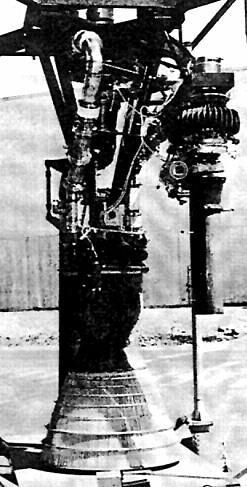
Home - Search - Browse - Alphabetic Index: 0- 1- 2- 3- 4- 5- 6- 7- 8- 9
A- B- C- D- E- F- G- H- I- J- K- L- M- N- O- P- Q- R- S- T- U- V- W- X- Y- Z
LR87 LH2
 LR-87 Lox/LH2 Versio Credit: NASA |
Status: Development ended 1961. Thrust: 667.00 kN (149,947 lbf). Specific impulse: 350 s. Specific impulse sea level: 350 s. Height: 4.00 m (13.10 ft). Diameter: 1.14 m (3.74 ft).
The Aerojet LR87 was the only engine known in the world that was operated (with modifications) using all three major propellant combinations: kerosene RP-1 and liquid oxygen; storable hydrazine and nitrogen tetroxide; and liquid hydrogen and liquid oxygen. The engine was tested with less success using nitrogen tetroxide and a gelled aluminized version of Aerozine-50. Some studies and development work were done on a fluorine/hydrogen version of the engine.
The Lox/LH2 version was the first large Lox/LH2 engine fired in the world. The entire development took place from 1958-1960, and was of the same magnitude as the parallel modification of the LR-87 engine to burn storable propellants for the Titan 2. The Lox/LH2 engine was essentially an LR-87 regeneratively cooled thrust chamber and nozzle, with a modified injector, and redesigned fuel pump. There were a total of 52 static tests run on full scale flight-weight hardware. Sea level thrust was as high as 59,000 kgf, equivalent to 68,000 kgf in vacuum. Simple impinging stream injectors were used rather than the more expensive conventional coaxial types used later on the M-l and SSME. All start-ups and shutdowns were smooth, and the combustion efficiency (C*) reached 99%. Operation was stable throughout and there were no major leakage problems. Early tests used pressurized propellants, but the later ones used flight-type turbopump assemblies.
In comparison with the Lox/Kerosene LR87, major changes were made on the injectors, and the RP-1 fuel pump was replaced by a single stage hydrogen pump specially designed for the purpose. The oxygen pump and its gearbox were unchanged from the original design.
When the time came for the competition for the 90,000 kgf J-2 engine for the Saturn V, Aerojet seemed well placed. In fact, Aerojet's proposal was ranked first in 10 areas and tied for the eleventh. But NASA selected Rocketdyne instead to develop the J-2 from scratch. A few years later the experience with the hydrogen LR87 did lead to Aerojet winning the ill-fated M-l contract. And twenty years later, when the USAF funded initial development of a lower cost Advanced Launch System, the original LR87 experience came in handy. For unlike the designs funded by NASA in the intervening years, Aerojet had achieved a very low cost hydrogen/oxygen engine at the dawn of the space age.
Thrust (sl): 578.000 kN (129,939 lbf). Thrust (sl): 59,000 kgf. Engine: 700 kg (1,540 lb). Area Ratio: 8. Thrust to Weight Ratio: 97.14.
Country: USA. Propellants: Lox/LH2. Stages: Titan C-2. Agency: Aerojet.
Back to top of page
Home - Search - Browse - Alphabetic Index: 0- 1- 2- 3- 4- 5- 6- 7- 8- 9
A- B- C- D- E- F- G- H- I- J- K- L- M- N- O- P- Q- R- S- T- U- V- W- X- Y- Z
© 1997-2019 Mark Wade - Contact
© / Conditions for Use